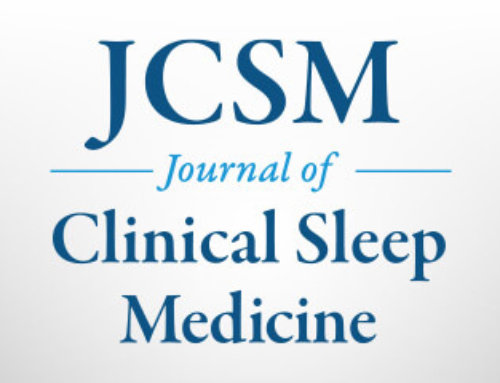WESTCHESTER, Ill. – The theme of Older Americans Month for 2008 is "Working Together for Strong, Healthy, and Supportive Communities." Working together, communities can improve older adults’ overall quality of life by helping them make changes in their lifestyles that can reduce the risk of disease, such as sleep. Unfortunately, many older adults often get less sleep than they need, for a number of different reasons. Poor sleep, as outlined in recent studies, is a precursor to serious health problems such as an increased risk of obesity, cardiovascular disease and diabetes. According to the American Academy of Sleep Medicine (AASM), although sleep patterns change as people age, disturbed sleep and waking up tired every day are not part of normal aging.
“As we get older, the amount of nightly sleep that we need remains the same as that of what we needed when we were younger. However the ability to get the sleep that we need does change. Older people have a hard time getting the sleep they need because of the interference of medical illnesses, the medications they take for those illnesses, and changes in their biological clock,” said Sonia Ancoli-Israel, PhD, professor of psychiatry at the University of California San Diego School of Medicine, director of the sleep disorders clinic at the Veterans Affairs San Diego Healthcare System, and co-director of the Laboratory for Sleep and Chronobiology at the UCSD General Clinic Research Center.
According to Ralph Downey III, PhD, chief of sleep medicine at the Sleep Disorders Center at Loma Linda University Medical Center in California, an associate professor of medicine, pediatrics and neurology at Loma Linda University, and an associate professor of psychology at the University of California at Riverside, it is normal for our body clocks to change as we get older.
“Time stands still for no one. However, with aging, our body clock acts a bit differently. We are less apt to sleep for long periods of time at night than teenagers. Rather, sleep is less deep, and we tend to sleep for shorter periods of time at night, with an increased likelihood of napping in the daytime,” said Dr. Downey.
There are many possible explanations for these changes. Older adults may produce and secrete less melatonin, the hormone that promotes sleep. They may also be more sensitive to changes in their environment, such as noise, and this may cause them to awaken. Further, older adults may also have other medical and psychiatric problems that can affect their sleep. Researchers have noted that people without major medical or psychiatric illnesses report better sleep.
In addition to being a risk factor for a depressive episode, persistent insomnia may perpetuate the illness in some elderly patients, and especially in those receiving standard care for depression in primary care settings, a study published in the April 1 issue of the journal SLEEP points out. The study was conducted on 1,801 elderly patients (60 years of age or older) with major depressive disorder and/or dysthymia, and found that patients with persistent insomnia were 1.8 to 3.5 times more likely to remain depressed, compared with patients with no insomnia. The findings were more evident in patients receiving usual care for depression than in patients receiving enhanced care. The findings were also stronger in subjects who had major depressive disorder as opposed to those with dysthymia alone.
A higher periodic leg movement index (PLMI) predicted less sleep at night in older people with cognitive impairment and sleep disturbance, according to a study published in the journal SLEEP on February 1. The study, which focused on 102 people between the ages of 59-96 years who had a clinical diagnosis of cognitive impairment, as well as average nightly sleep of seven or less hours and daytime sleep of 30 minutes or longer, found that 21.6 percent had at least one painful condition and 45.1 percent were diagnosed with depression. The participants’ average PLMI was 17.3, with 33.3 percent having a PLMI greater than 15. Time in bed at night exceeded eight hours, yet participants averaged only 5.5 hours of sleep. PLMI, time in bed, and age explained 43.6 percent of the variance in total sleep time.
One of the first large-scale studies to examine the association of sleep behaviors, neuromuscular performance and daytime function in a community dwelling of older women finds that poorer sleep is associated with worse physical function in older women during the daytime, a study published in the journal SLEEP in 2007 found. The study, conducted on 2,889 women, found that women who slept less than six hours per night walked 3.5 percent slower than those who slept six to 6.8 hours. Those who slept greater than or equal to seven-and-a-half hours took 4.1 percent longer to complete five chair stands than those who slept 6.8 to seven-and-a-half hours. With higher wake after sleep onset, gait speed was 9.1 percent slower. It took 7.6 percent longer to complete five chair stands, and odds of functional limitation were 1.8 percent higher. Women with one to 1.8 hours of daytime sleep had higher odds of a functional limitation than those with less than 0.5 hours.
A study published in the journal SLEEP in 2006 found that longer bouts with insomnia were more common in the older population, who are also more likely to be taking types of sedatives that have particular problems with addiction and side-effects.
According to Dr. Ancoli-Israel, common sleep disorders in the elderly include:
- Insomnia, the most common sleep complaint, which affects almost half of adults 60 and older.
- Obstructive sleep apnea (OSA), which can elevate the risk for high blood pressure, stroke, heart disease, and cognitive problems. Snoring, a symptom of OSA, is a very common condition affecting nearly 40 percent of adults, and is more common among older people.
- Restless legs syndrome, where one can experience uncomfortable feelings in the legs such as tingling, crawling or pins and needles. It affects more than 20 percent of people 80 years and older.
- Periodic limb movements, a condition that causes people to jerk and kick their legs every 20-40 seconds during sleep. One study found that roughly 40 percent of older adults have at least a mild form of periodic limb movements.
Not sleeping well can lead to a number of problems. Older adults who have poor nighttime sleep are more likely to have a depressed mood, attention and memory problems, excessive daytime sleepiness, more nighttime falls and use more over-the-counter or prescription sleep aids.
While most people require seven to eight hours of sleep a night to perform optimally the next day, older adults might find this harder to obtain. Older adults must be more aware of their sleep and maintain good sleep hygiene by following these tips:
- Establishing a routine sleep schedule.
- Avoiding utilizing bed for activities other than sleep or intimacy.
- Avoiding substances that disturb your sleep, like alcohol or caffeine.
- Not napping during the day. If you must snooze, limit the time to less than one hour and no later than 3 p.m.
- Stick to rituals that help you relax each night before bed. This can include such things as a warm bath, a light snack or a few minutes of reading.
- Don’t take your worries to bed. Bedtime is a time to relax, not to hash out the stresses of the day.
- If you can’t fall asleep, leave your bedroom and engage in a quiet activity. Return to bed only when you are tired.
- Keep your bedroom dark, quiet and a little cool.
Those who have trouble sleeping are advised to see a sleep specialist at a facility accredited by the AASM.
More information about is available from the AASM about:
SleepEducation.com, a patient education Web site created by the AASM, provides information about various sleep disorders, the forms of treatment available, recent news on the topic of sleep, sleep studies that have been conducted and a listing of sleep facilities.
AASM is a professional membership organization dedicated to the advancement of sleep medicine and sleep-related research.
To arrange an interview with an AASM spokesperson, please contact Jim Arcuri, public relations coordinator, at (708) 492-0930, ext. 9317, or
jarcuri@aasm.org.
SLEEP 2008, the 22nd Annual Meeting of the Associated Professional Sleep Societies and the world’s largest annual gathering of sleep scientists and sleep medicine professionals, will take place in Baltimore, Maryland, from June 9-12, 2008. SLEEP 2008 will bring together an international body of 5,000 leading researchers and clinicians, who will present and discuss over 1,100 new findings and medical developments related to sleep and sleep disorders. The deadline to register is Friday, May 30, 2008. Contact Jim Arcuri at (708) 492-0930, ext. 9317, or jarcuri@aasm.org for more information or to register for a free press pass. More details, including the program schedule and a list of invited lecturers, are available at www.SleepMeeting.org.
# # #








